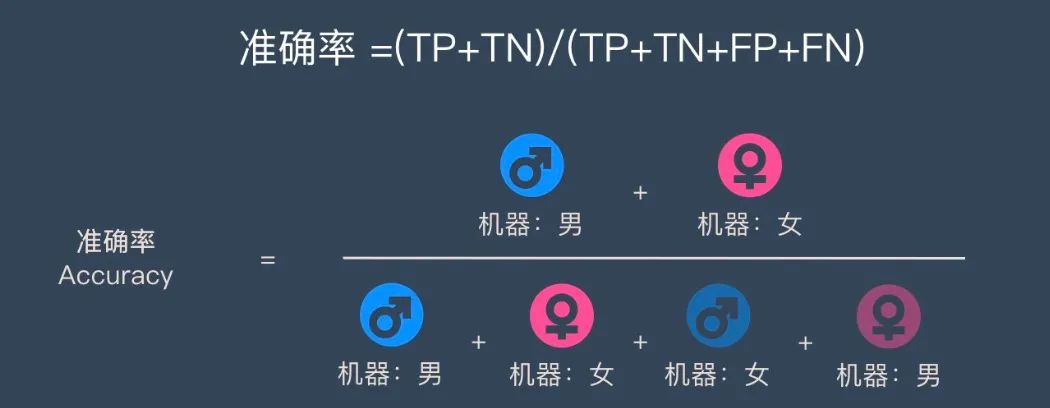【机器学习模型评估】:性能度量标准,精准评估模型
发布时间: 2024-09-01 19:03:33 阅读量: 123 订阅数: 40 


# 1. 机器学习模型评估概述
在机器学习中,模型评估是一个至关重要的步骤,它允许我们理解模型在未见数据上的表现,并指导我们进行模型的选择和优化。本章将从基础概念开始,介绍机器学习模型评估的目的和意义,以及如何选择合适的评估方法来衡量模型的性能。
机器学习模型的评估不仅仅是对模型准确性的一个快速检查,它还涉及到对模型泛化能力的深入理解,以及在特定业务场景下的适用性分析。评估过程需要通过一系列的指标来量化模型的预测效果,这些指标包括分类准确度、召回率、精确率、混淆矩阵等。正确地理解和运用这些评估指标能够帮助我们避免一些常见的评估陷阱,并对模型做出更加客观和公正的评价。
此外,为了确保评估结果的可靠性和稳定性,交叉验证是一种常用的方法,它能够充分利用有限的数据集,评估模型在不同数据子集上的表现。通过本章的学习,读者将掌握模型评估的基本原则和方法,并为进一步深入研究打下坚实的基础。
# 2. 基本性能度量标准
在机器学习中,模型的性能评估是至关重要的环节,因为它是量化模型预测能力的关键手段。本章将重点探讨分类问题和回归问题的性能度量方法,为后续更深入的模型评估和优化打下坚实的基础。
### 2.1 分类问题的性能度量
分类问题是将实例数据分配到合适的类别中,例如,垃圾邮件检测、疾病诊断等。性能度量标准帮助我们量化分类模型的准确性、可靠性和有效性。
#### 2.1.1 准确率
准确率是最直观的性能度量指标,它计算了被正确分类的样本数占总样本数的比例。尽管准确率简单易懂,但在数据不平衡的情况下可能会产生误导。
```python
# 计算准确率的代码示例
from sklearn.metrics import accuracy_score
# 假定真实标签和预测标签
true_labels = [1, 2, 3, 4, 5]
predicted_labels = [1, 2, 3, 4, 4]
# 计算准确率
accuracy = accuracy_score(true_labels, predicted_labels)
print(f"Accuracy: {accuracy}")
```
在上述代码中,`accuracy_score` 函数从 `sklearn.metrics` 模块用于计算准确率。准确率的计算公式是:`accuracy = (TP + TN) / (TP + TN + FP + FN)`,其中 TP、TN、FP 和 FN 分别代表真正例、真负例、假正例和假负例的数量。
#### 2.1.2 精确率、召回率和F1分数
精确率和召回率是分类问题中常用的性能度量指标,它们从不同角度反映了模型的预测能力。
精确率关注的是被模型预测为正的样本中有多少是真的正样本,其计算公式为:`precision = TP / (TP + FP)`。
召回率关注的是所有正样本中有多少被模型正确地识别出来,其计算公式为:`recall = TP / (TP + FN)`。
F1分数是精确率和召回率的调和平均值,它综合考量了二者的影响,是一种衡量模型平衡性能的指标,计算公式为:`F1 = 2 * (precision * recall) / (precision + recall)`。
```python
from sklearn.metrics import precision_score, recall_score, f1_score
# 计算精确率、召回率和F1分数
precision = precision_score(true_labels, predicted_labels, average='macro')
recall = recall_score(true_labels, predicted_labels, average='macro')
f1 = f1_score(true_labels, predicted_labels, average='macro')
print(f"Precision: {precision}")
print(f"Recall: {recall}")
print(f"F1 Score: {f1}")
```
#### 2.1.3 混淆矩阵及其分析
混淆矩阵是评估分类器性能的另一种重要工具,它显示了实际类别与预测类别的对比。混淆矩阵能够提供关于类别不平衡和分类错误类型的重要信息。
```markdown
| | 预测类别A | 预测类别B | 预测类别C |
|----------|-----------|-----------|-----------|
| 实际类别A | TP | FN | FN |
| 实际类别B | FP | TN | FN |
| 实际类别C | FP | FN | TN |
```
在混淆矩阵中,TP代表真正例,FN代表假负例,FP代表假正例,TN代表真负例。通过分析混淆矩阵可以识别模型的弱点,例如,在某些类别上的预测能力较弱,或是存在类别不平衡的问题。
### 2.2 回归问题的性能度量
回归问题是预测连续值的输出,常见的回归任务包括房价预测、股票价格预测等。与分类问题不同,回归问题的性能度量关注的是预测值与真实值之间的差异程度。
#### 2.2.1 均方误差(MSE)和均方根误差(RMSE)
均方误差是回归问题中最常用的性能度量标准之一,它计算了每个样本的误差(真实值与预测值之差)的平方,然后求均值。计算公式为:`MSE = (1/N) * Σ(y_i - ŷ_i)²`,其中 `y_i` 是真实值,`ŷ_i` 是预测值,N 是样本总数。
均方根误差是均方误差的平方根,它使得误差的度量单位与原始数据相同,从而更容易解释。计算公式为:`RMSE = sqrt(MSE)`。
```python
from sklearn.metrics import mean_squared_error
# 计算MSE和RMSE的代码示例
actual = [1, 2, 3, 4, 5]
predicted = [1.1, 2.1, 2.9, 4.1, 5.1]
# 计算MSE
mse = mean_squared_error(actual, predicted)
# 计算RMSE
rmse = mse ** 0.5
print(f"MSE: {mse}")
print(f"RMSE: {rmse}")
```
#### 2.2.2 平均绝对误差(MAE)
平均绝对误差计算每个样本预测误差的绝对值,然后求平均。它是对模型预测误差的另一种度量方式,相较于MSE对异常值的敏感性更低。计算公式为:`MAE = (1/N) * Σ|y_i - ŷ_i|`。
```python
from sklearn.metrics import mean_absolute_error
# 计算MAE的代码示例
mae = mean_absolute_error(actual, predicted)
print(f"MAE: {mae}")
```
#### 2.2.3 决定系数(R²)
决定系数(R²)用于评估回归模型的拟合优度。R²值的范围从0到1,R²值越接近1,表示模型越能解释数据的变异性。计算公式为:`R² = 1 - (SS_res / SS_tot)`,其中 SS_res 是残差平方和,SS_tot 是总平方和。
```python
from sklearn.metrics import r2_score
# 计算R²的代码示例
r2 = r2_score(actual, predicted)
print(f"R² Score: {r2}")
```
0
0





